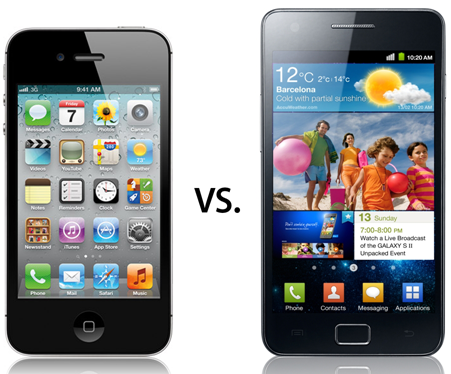We’ve been doing a lot of comparison posts recently, mostly involving the comparing of one feature of the iPhone 4S against a comparable feature of another smartphone and we’ll be doing one more comparison today: the video recording performance of the iPhone 4S versus that of the Galaxy S II.
The comparison video comes straight from: us. Yes, our very own Steven Chi came up with this video, in which viewers get to compare, side-by-side, the video recording performance of two smartphone giants: the Galaxy S II and the iPhone 4S.
The Samsung Galaxy S II was announced earlier this year in February at Mobile World Congress and was launched in the US as Epic 4G Touch for Sprint just a few weeks ago. The superphone packs a dual-core Exynos chip clocked at 1.2 GHz, 1GB of RAM and – of course – an 8 megapixel camera with autofocus, an LED flash and image stabilization which can record video at Full HD 1080p at 30FPS.
The iPhone 4S, on the other hand, was announced both announced and launched this earlier this month. It has a dual-core fastest-in-its-class Apple A5 chip clocked at 800MHz, 512MB of RAM and an 8 megapixel camera with autofocus, LED flash, image and video stabilization which can record video at Full HD 1080p at 30FPS.
So what is the difference? Both have an 8 megapixel camera that can shoot 1080p video at 30FPS. Both cameras sound the same, at least on paper.
Well, the difference lies in optics i.e. the lens. From what information we have, the iPhone 4S has more advanced optics; Apple uses plenty of tricks that add up to much better photo and video quality: a Hybrid IR filter ensures colors are more accurate and uniform, the large f/2.4 aperture combined with the backside-illuminated sensor lets in more light which, well, makes photos brighter and makes low-light performance significantly better. The camera on the iPhone 4S is faster too, thanks to the image signal processor inside the A5 chip which speeds up the time it takes to snap successive photos.
We’re sorry if that sounded like one big advertisement to our readers, but it really is true and we’ve got a comparison video to prove it:
Note: Watch video in 1080p to appreciate the difference in camera quality.
You may also like to check out:
- Untouched Camera Pictures from iPhone 4S 8 Megapixel Shooter; This May Just Be The Best Mobile Phone Camera Ever! [PHOTOS]
- iPhone 4S vs iPhone 4 – Camera Test [Head-to-Head Video Comparison]
- iPhone 4S’ Camera Can Shoot HD 1080p Video Almost As Good As This Canon DSLR Camera [VIDEO]
You can follow us on Twitter or join our Facebook page to keep yourself updated on all the latest from Microsoft, Google and Apple.

